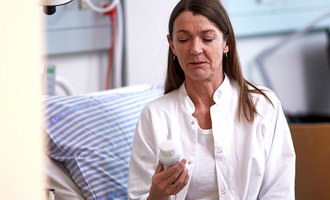Optimal dietary protein for maintaining a strong and healthy later life
Protein malnutrition is a prevalent issue among hospitalized elderly1,2. This condition has various negative effects on morbidity, mortality, quality of life and by extension healthcare costs2-4.
Whey protein is widely regarded as one of the highest quality protein sources available5. It surpasses the essential amino acid requirements for adults as established by the United Nation’s Food and Agriculture Organization6 . Additionally, whey protein’s high proportion of leucine makes it a potent stimulator of muscle protein synthesis and thus help counteract loss of muscle mass7.
Whey proteins – supporting the dietary management of sarcopenia
Sarcopenia is a syndrome characterized by the progressive loss of skeletal muscle mass and function, which can affect people of all ages but is more common among the elderly8. Sarcopenia has a substantial impact on the overall quality of life and can contribute to falls, hospitalization, institutionalization, and even mortality9,10. To enhance skeletal muscle mass, it is beneficial to ensure an adequate intake of high-quality proteins, such as dairy proteins11,12. Whey protein's potent ability to stimulate muscle protein anabolism is attributed to its abundance of essential amino acids, such as branched-chain amino acids (BCAAs) and leucine, as well as its rapid digestion7.
Arla Foods Ingredients has a broad range of whey-based ingredients that can be incorporated in medical nutrition targeting the dietary management of protein malnutrition and sarcopenia. Check our product portfolio.
References:
- Weijzen, M.E.G., et al., Protein Intake Falls below 0.6 g·kg -1 ·d -1 in Healthy, Older Patients Admitted for Elective Hip or Knee Arthroplasty, in Journal of Nutrition, Health and Aging. 2019, Springer-Verlag France. p. 299-305.
- Schuetz, P., et al., Management of disease-related malnutrition for patients being treated in hospital. The Lancet, 2021. 398(10314): p. 1927-1938.
- Norman, K. and L. Otten, Financial impact of sarcopenia or low muscle mass – A short review. Clinical Nutrition, 2019. 38(4): p. 1489-1495.
- Eckert, C., et al., Malnutrition Risk, Rurality, and Falls among Community-Dwelling Older Adults. J Nutr Health Aging, 2021. 25(5): p. 624-627.
- Mathai, J.K., Y. Liu, and H.H. Stein, Values for digestible indispensable amino acid scores (DIAAS) for some dairy and plant proteins may better describe protein quality than values calculated using the concept for protein digestibility-corrected amino acid scores (PDCAAS). British Journal of Nutrition, 2017. 117(4): p. 490-499.
- Dietary protein quality evaluation in human nutrition. Report of an FAQ Expert Consultation, in FAO Food Nutr Pap. 2013. p. 1-66.
- Devries, M.C. and S.M. Phillips, Supplemental protein in support of muscle mass and health: advantage whey, in J Food Sci. 2015: Exercise Metabolism Research Group (EMRG), Dept. of Kinesiology, McMaster Univ, 1280 Main St. W, IWC E210, Hamilton, ON, L8S 4K1, Canada. p. A8-a15.
- Cruz-Jentoft, A.J., et al., Sarcopenia: Revised European consensus on definition and diagnosis, in Age and Ageing. 2019. p. 16-31.
- Gariballa, S. and A. Alessa, Sarcopenia: Prevalence and prognostic significance in hospitalized patients. Clinical Nutrition, 2013. 32(5): p. 772-776.
- Landi, F., et al., Sarcopenia as a risk factor for falls in elderly individuals: Results from the ilSIRENTE study. Clinical Nutrition, 2012. 31(5): p. 652-658.
- Hanach, N.I., F. Mccullough, and A. Avery, The Impact of Dairy Protein Intake on Muscle Mass, Muscle Strength, and Physical Performance in Middle-Aged to Older Adults with or without Existing Sarcopenia: A Systematic Review and Meta-Analysis. 2019.
- Nabuco, H.C.G., et al., Effects of whey protein supplementation pre- or post-resistance training on muscle mass, muscular strength, and functional capacity in pre-conditioned olderwomen: A randomized clinical trial. Nutrients, 2018. 10(5): p. 1-14.






